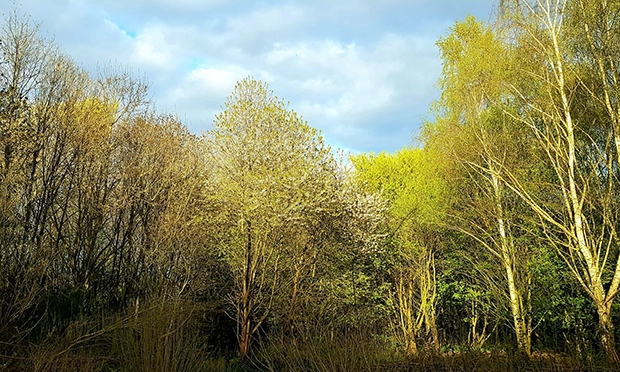Thames Water to cut down 80 trees to protect pipes beneath Hackney woodland

Wick Woodland. Photograph: Gerry Tissier
The upcoming felling of 80 trees in Hackney to prevent damage to water pipes has prompted a phlegmatic response from nature-lovers – though one hopes it will “spark a broader conversation” about urban development.
Thames Water is set to cut down a group of trees in Wick Woodland that were planted 25 years ago, close to water mains that serve 150,000 homes.
The utility giant says the work is needed after a burst pipe flooded walkways in the park, which is owned by Hackney Council, in October 2020.
The work will get underway on Monday 27 November and is expected to be completed over a fortnight.
Arboriculturalist Russell Miller, acting as a consultant on the project, said the trees, which include ash, oak, birch, poplar, cherry, hazel and alder, are not very old.
“Woodland needs a diversity of species,” he explained. “By felling the trees, we will be increasing the canopy of the woodland and encouraging ground flora and fauna and shrub layers.”
The trees will be cut to 1.2 metres in height, which will stop them growing.
Tree surgeons will then use a technique called ring-barking to cause the trees to die.
The tree trunks will be left in the wood to decompose and create habitats for insects and other wildlife.
Other trees will be pollarded, or pruned, to reduce their size and “leave a structural diversity”, said Miller.
The council said there are plans to plant 150 native shrubs on the site, and noted that it has introduced 17,000 trees to the borough in recent years.
Miller added: “There’s no reason for people to be upset. This is of benefit to the ecology of the woodland. We will be doing this and sustaining a sensible, managed woodland.”
Gerry Tissier, a biodiversity expert for Sustainable Hackney, which supports environmental groups, agreed: “It will encourage biodiversity at the site, as Wick Woodland is structurally poor.
“It is a well thought-out habitat enhancement plan.”
Rich Weltch, director of Greenways Forest School, which teaches children about nature at Wick Woodland, said: “The loss of any trees in such a rare woodland setting is indeed disheartening.
“These trees not only contribute to the area’s biodiversity but also form an integral part of the magical experience we aim to provide for the children at our forest school.”
He added: “We understand the practical reasons for the felling, particularly in the context of public safety and infrastructure maintenance.
“However, we hope that this incident sparks a broader conversation about balancing urban development with the preservation of natural spaces.”
The school has temporarily moved to a different site on the woodland for its activities.
Weltch said: “We hope that measures will be taken to prevent similar occurrences in the future, ensuring the longevity and health of this beloved woodland area.”
Christine Kings from Tree Musketeers, a local organisation that plants and cares for trees, said: “None of us want this to happen. There’s no point in getting upset about it as Thames Water have legal responsibility for the pipes and are entitled to do this.”
Kings has helped plant trees at Wick Woodland in the past.
She added: “There are pipes all over London and, until they burst, nobody thinks what is there. People do not always know where pipes are.”
The Tree Musketeers will be keeping an eye on the management of the land.
“One of the concerns is that the area just becomes bramble,” Kings said.
A Thames Water spokesperson said: “It’s our job to keep the taps flowing for customers. In order to protect water supply for Hackney residents, we need to carefully remove and manage trees along an eight-metre wide corridor of a mains pipe situated under Wick Woodland.
“The mains pipe supplies water to almost 150,000 properties in the area and it’s critical our engineers can gain speedy access to maintain this important pipe in the future.”
Thames Water is working with Hackney Council and the London Wildlife Trust on the project.
The spokesperson added: “As part of the work, we also plan to pollard some of the trees and plant 150 native shrubs to establish a woodland ride, which will create better habitat for woodland butterflies and birds such as blackcap and chiffchaff.
“We will also create new habitats for wood mice, toads and solitary bees using timber from the trees we have to remove.”
The company will also install bat and owl boxes.
